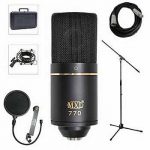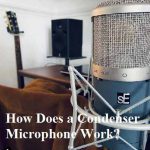Condenser mics are generally considered to be better for streaming than other types of microphones, because they tend to produce a clearer and more natural-sounding audio signal. However, they can also be more sensitive to background noise, so you may need to experiment with placement and/or use a pop filter to reduce plosives if you plan on using one for your stream.
Whether you’re a beginner streamer or a seasoned pro, one question you might have is: are condenser mics good for streaming?
The answer is… it depends! Let’s break down the pros and cons of using a condenser mic for streaming so you can decide if it’s the right fit for your setup.
Condenser mics are popular among streamers because they tend to produce clear, high-quality audio. They’re also generally more sensitive than other types of microphones, which means they can pick up a wider range of sounds. That said, condenser mics can be more prone to picking up background noise – so if you have a lot of ambient noise in your streaming space, it might not be the best option.
Another consideration is that condenser mics typically require phantom power – meaning you’ll need an external power source to use them. This isn’t necessarily a deal breaker, but it’s something to keep in mind if you’re looking for an all-in-one solution. Overall, whether or not a condenser mic is good for streaming comes down to personal preference and your specific needs.
If you want high-quality audio and don’t mind dealing with a little extra background noise, then a condenser mic could be a great option for you. But if you need something that will eliminate ambient noise completely, there are other microphone choices out there that might be better suited for your needs.
Also Read: Best Condenser Mic Under 200
Table of Contents
Dynamic Vs. Condenser Microphone – Which is best for Streaming?
Are Dynamic Or Condenser Mics Better for Streaming?
There are a few things to consider when trying to decide whether dynamic or condenser microphones are better for streaming.
The first is the purpose of the stream. If you’re just streaming audio, like music or a podcast, then either type of mic will work fine.
However, if you’re planning on using video as well, then you’ll want to use a condenser mic so that your voice comes through clearly. Another consideration is the environment in which you’ll be streaming. If it’s a noisy place, like a bar or club, then a dynamic mic is probably your best bet since they’re less sensitive to background noise.
On the other hand, if you’re in a quiet room, then a condenser mic will give you better sound quality overall. Ultimately, it comes down to personal preference and what works best for your particular setup and needs. If you have the option, try out both types of microphones and see which one sounds better to you.
What are the Disadvantages of the Condenser Mic?
The main disadvantages of condenser microphones are that they require phantom power, which means an extra power supply, and they are also more delicate and expensive than dynamic microphones. Condenser microphones are generally used for studio recording because they capture a wider frequency range and have a higher signal-to-noise ratio than dynamic microphones.
Also Read: mxl 770 review
What Kind of Mic is Better for Streaming?
If you’re looking to get into live streaming, one of the most important things you need to consider is what kind of microphone you’ll be using. There are a lot of different options out there, and it can be tough to know which one is right for you. In this article, we’ll break down the different types of microphones and help you decide which one is best for your needs.
One of the most important things to consider when choosing a microphone for streaming is the type of connection it uses. USB microphones are very popular because they’re easy to set up and use with just about any computer. However, they can also introduce latency issues if not used properly.
If you’re looking for the lowest possible latency, an XLR microphone is a better option. These require an external audio interface, but they offer much lower latency than USB microphones. Another thing to keep in mind is the pick-up pattern.
Most streamers will want a cardioid microphone, which means it only picks up sound from directly in front of it. This helps reduce background noise and makes your voice sound clearer on stream. If you’re doing any sort of gaming commentary or talking over gameplay footage, however, you may want to consider a directional or bidirectional mic so that you can more easily hear both your voice and the game audio at the same time.
Finally, think about what kind of features you might want in a microphone. Some models come with built-in pop filters or shock mounts to help reduce unwanted noise; others have LED lights that indicate when they’re muted or on standby; and some even have built-in headphone jacks so that you can monitor your own audio while streaming. Decide what’s most important to you and choose accordingly.
No matter what kind of streamer you are, there’s a perfect microphone out there for you – it just takes a little bit of research to find it!
Also Read: best affordable condenser mic for vocals
Should I Get a Dynamic Or Condenser Microphone for Gaming?
If you’re looking to get the best possible sound quality for your gaming setup, then you’ll need to invest in a good quality microphone. But with so many different types and brands of microphones out there, it can be tough to know which one is right for you. So, if you’re wondering whether you should get a dynamic or condenser microphone for gaming, here’s what you need to know.
Dynamic microphones are typically more affordable than condenser microphones, and they’re also more resistant to feedback. This makes them a great option if you plan on using your microphone for gaming applications where there might be a lot of background noise. However, dynamic microphones don’t tend to capture as much detail as condenser microphones do, so if sound quality is your top priority then a condenser mic is probably the better choice.
Condenser microphones are generally more expensive than dynamic models, but they offer superior sound quality. If you want your games to sound as realistic and immersive as possible, then a condenser microphone is definitely the way to go. Just be aware that they can be more sensitive to background noise than dynamic mics, so if that’s an issue in your gaming environment then you might want to consider getting a shock mount or pop filter to help reduce any unwanted sounds.

Best Dynamic Microphone for Streaming
In the world of streaming, having a high-quality microphone is essential in order to be heard clearly by your viewers. There are many different types and brands of microphones out there, so it can be difficult to know which one is the best for you. If you’re looking for a dynamic microphone that will provide clear sound quality for your stream, here are some of the best options available.
The Shure SM7B is a popular choice for many streamers, as it offers great sound quality and is very versatile. It can be used for both vocals and instruments, and has a built-in pop filter to reduce background noise. Another option is the Audio-Technica AT2020, which is also a versatile microphone that produces clear sound.
It’s affordable and easy to set up, making it a great choice for those new to streaming. If you’re looking for something with a bit more power, the Blue Yeti Pro is a great option. It’s ideal for podcasting and streams with multiple people, as it picks up sound from all around the room.
It’s also very user-friendly, with simple controls that make it easy to use even if you’re not an audio expert. No matter what your needs are, there’s sure to be a dynamic microphone out there that’s perfect for you. With so many great options available, you’re sure to find one that will help take your stream to the next level!
Conclusion
Condenser microphones are often thought of as being the best type of microphone for streaming, but is this really the case? Let’s take a look at the pros and cons of using a condenser mic for streaming. The main advantage of using a condenser mic for streaming is that they tend to produce a very clear and detailed sound.
This is because condenser mics have a much higher frequency response than other types of microphone, which means they can pick up more highs and lows. This can be great for giving your stream a more professional sound. However, there are also some disadvantages to using a condenser mic for streaming.
One downside is that they tend to be quite sensitive, which means they can pick up unwanted background noise like computer fans or air conditioning units. They also require phantom power, which means you’ll need an external power source to use them. Overall, though, condenser mics are still generally considered to be the best option for streaming if you’re looking for high quality audio.
Relevant Post:
Why is My Condenser Mic Not Working?
How to Connect Condenser Mic to Bluetooth Speaker?
How to Connect Condenser Mic to Mac?
How to Connect Condenser Mic to Speaker?
How to Connect a Condenser Mic to a Pc?
Are you a user of a condenser mic?
How to Connect Condenser Mic to Audio Interface?
Does a condenser mic need phantom power?
How to use condenser mic on tiktok?

Williams Kane is a blogger and writer. He’s passionate about writing and connecting with the community, especially when it comes to sharing his ideas through writing.
I am a versatile author with a passion for exploring a wide range of topics on our multi-niche website. With a background in research and a love for writing, I bring a unique blend of expertise to our platform.
My journey began in the world of science, where I earned a degree in biology and developed a deep fascination for the natural world. This background enables me to delve into topics related to ecology, environmental conservation, and the wonders of the animal kingdom.
However, my curiosity knows no bounds, and I have ventured into various other niches as well. From technology trends and digital innovations to health and wellness tips, I strive to provide well-researched and engaging content that informs and entertains our diverse audience.
Furthermore, my dedication to staying current with the latest developments in each niche ensures that our readers receive up-to-date and reliable information. Whether it’s deciphering complex scientific concepts or simplifying tech jargon, I take pride in making complex subjects accessible to all.
Join me on our multi-niche journey, where we explore the depths of knowledge and share insights on a multitude of topics to inspire, educate, and entertain.






